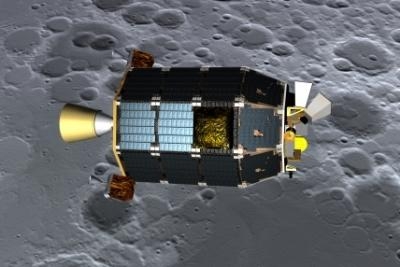Tue, Oct 08, 2013
Spacecraft Was Launched September 6 From Wallops Island, VA
Four burns completed by Aerojet Rocketdyne 100-lbf High Performance Apogee Thruster (HiPAT(TM)) bipropellant engine enabled NASA's Lunar Atmosphere and Dust Environment Explorer (LADEE) to achieve lunar orbit on Oct. 6. Two phasing burns, each of which increased the apogee, were followed by two Lunar Orbit Insertion burns.

"From the crewed Apollo vehicle to the orbiters of Lunar Prospector and LADEE, Aerojet Rocketdyne provides propulsion and power for lunar exploration," said Aerojet Rocketdyne Vice President of Space Systems, Warren Yasuhara. "LADEE is designed to characterize the tenuous lunar atmosphere and dust environment--an important study in preparation for returning astronauts to the moon."
Demonstrating NASA's success in leveraging the capability of commercially proven technology for U.S. Government missions, Aerojet Rocketdyne delivered the HiPAT to SSL for integration into the LADEE propulsion system in March 2011. The bi-propellant propulsion system is a variant of the mission critical system, based on the HiPAT engine, which SSL has successfully used over many years for its geostationary commercial satellites.
Advantages of the HiPAT engine include its ability to operate over a broad range of pressures and propellant mixtures that make it uniquely suitable for missions like LADEE which require multiple burns over a relatively long period of time. The HiPAT will continue to periodically re-boost LADEE as it gathers detailed information about the lunar atmosphere, conditions near the surface and environmental influences on lunar dust.
LADEE was launched on Sept. 6, 2013, from NASA's Wallops Flight Facility in Virginia aboard the Minotaur V rocket. The Minotaur V, provided by the U.S. Air Force, was a repurposed three-stage Peacekeeper Missile to which Orbital Sciences Corp., Dulles, VA, added two additional stages and new avionics and guidance software. Aerojet Rocketdyne built the SR119 Peacekeeper second stage solid rocket motor that helped launch LADEE into an Earth-centric trajectory.
(Artist's concept of LADEE in lunar orbit provided by NASA)
More News
“We have seen astounding demand for the G800, and the entire Gulfstream team is excited to begin making deliveries to our customers. The G800 is entering service with extraor>[...]
Aero Linx: Recreational Aviation Australia (RAAus) Recreational Aviation Australia is progressively working towards improving safety outcomes through a holistic approach to safety >[...]
Classic Klyde Morris From 11.07.16 (and Remembering Bob...) FMI: www.klydemorris.com>[...]
Also: GADFLY AI-Driven Engine Analysis, Knockoff Iranian Drones, Russian Surveillance, 40 NASA Missions Chopped This year’s Zenith Homecoming event will soon be taking off at>[...]
Also: H55 Completes American Tour, Robinson Trade-Ins, Retired AV-8B Harrier, NS-35 Mission Organizers of the iconic annual Air Race Classic will soon be opening registration for t>[...]
 Aero-News: Quote of the Day (08.28.25)
Aero-News: Quote of the Day (08.28.25) ANN's Daily Aero-Linx (08.28.25)
ANN's Daily Aero-Linx (08.28.25) Classic Klyde Morris (08.25.25)
Classic Klyde Morris (08.25.25) Airborne 08.25.25: Zenith Homecoming, VP Racing, Affordable Flying Expo 2025
Airborne 08.25.25: Zenith Homecoming, VP Racing, Affordable Flying Expo 2025 Airborne 08.22.25: ARC Spinoff, Nat'l Championship Air Races, Hawkins Accident
Airborne 08.22.25: ARC Spinoff, Nat'l Championship Air Races, Hawkins Accident



